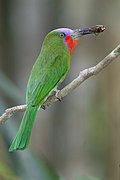| Nyctyornis | |
|---|---|
 | |
| Blue-bearded bee-eater (Nyctyornis athertoni) | |
| Scientific classification | |
| Kingdom: | Animalia |
| Phylum: | Chordata |
| Class: | Aves |
| Order: | Coraciiformes |
| Family: | Meropidae |
| Genus: | Nyctyornis Jardine & Selby, 1830 |
| Type species | |
| Merops amictus [1] Temminck, 1824 | |
| Species | |
See text | |
Nyctyornis is a genus of the bee-eaters, near passerine birds in the family Meropidae. There are just two members of this group, which occur in tropical south and southeastern Asia. [2]
| Image | Scientific name | Common name | Distribution |
|---|---|---|---|
 | Nyctyornis amictus | Red-bearded bee-eater | Southeast Asia |
 | Nyctyornis athertoni | Blue-bearded bee-eater | Indian subcontinent and parts of Southeast Asia |
The genus Nyctyornis was introduced by the naturalists William Jardine and Prideaux John Selby in 1830. [3] [4] The name comes from the Ancient Greek nukt meaning nocturnal or night and ornis meaning bird. [5] A molecular phylogenetic study published in 2007 showed that the genus is basal and forms a sister group to the remaining members of the bee-eater family. [6]
Like other bee-eaters, Nyctyornis species are colourful birds with long tails, long downturned bills and pointed wings. They are large bee-eaters (blue-bearded is the largest of all bee-eaters), [7] predominantly green, with a face colour as indicated by the species' name. This colour extends on to the slightly hanging throat feathers to form the "beard". [8]
The two Nyctyornis species are the only bee-eaters that lack an eye-stripe and that have bi-coloured beaks. [6] Their calls also differ from those of other bee-eaters and are somewhat similar to the noises made by rollers. [9] Their size and more rounded wings give a heavier flapping flight that is less graceful than that of members of the genus Merops . [9]
In common with other bee-eaters, they predominantly eat insects, especially bees, wasps and hornets, which are caught in the air, but they have a rather different strategy. They hunt alone or in pairs, rather than in groups, and sit motionless for long periods before pursuing their prey. [9] The blue-bearded bee-eater will also clamber in foliage for insects, and bees are sometimes attracted by the bright blue beard of a perched bird, presumably mistaking it for a flower. [10] They nest in burrows tunneled into the side of sandy banks, but do not form colonies. [11]







